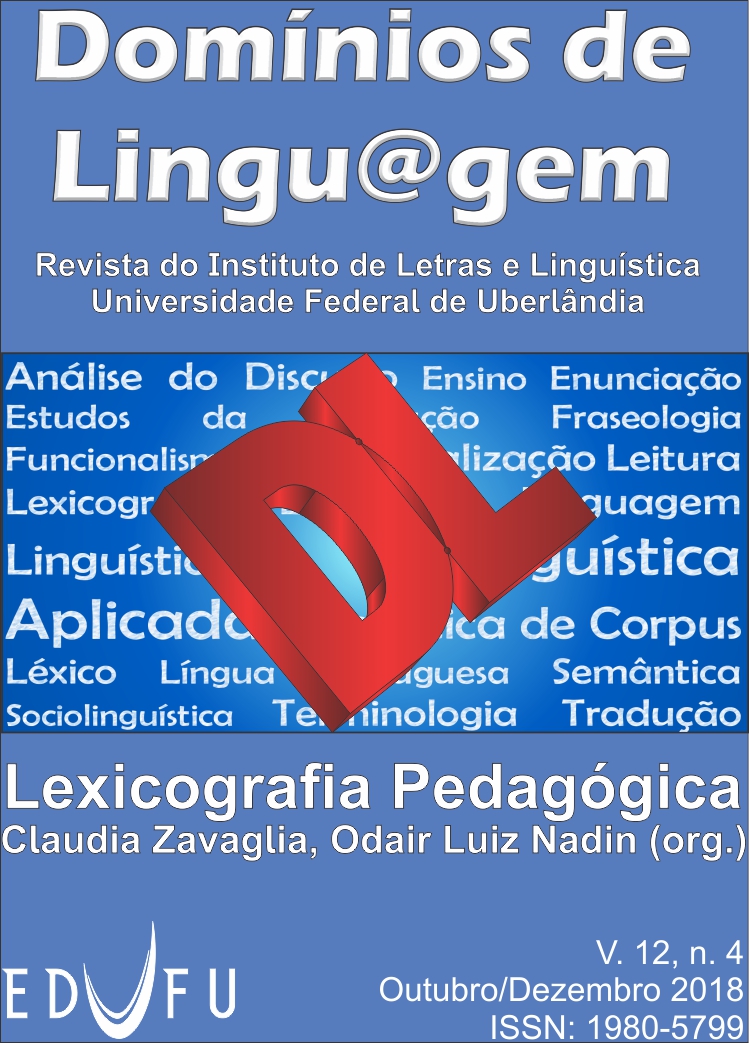Marcas de uso e redes medioestruturais de verbetes sobre homossexual masculino em dicionários escolares
DOI:
https://doi.org/10.14393/DL36-v12n4a2018-17Palavras-chave:
Homossexual masculino, Dicionário escolar, Marcas de uso, PejorativoResumo
Nosso objetivo foi investigar quais as marcas de uso utilizadas nos dicionários escolares tipo 3 do Programa Nacional do Livro Didático 2012 para indicar as restrições e os contextos de uso de palavras relacionadas a homossexual masculino, bem como suas implicações para a compreensão dos sentidos ali expressos. Buscamos fundamentação teórica nos campos da Metalexicografia e da Lexicografia Pedagógica (WELKER, 2004; PONTES, 2009; 2012; GARRIGA ESCRIBANO, 1994; 1995; FAJARDO, 1997) e operamos uma pesquisa descritiva e qualitativa. Apresentamos um levantamento de 11 entradas relacionadas a homossexual masculino, totalizando 44 verbetes extraídos de cinco dicionários escolares. A partir das definições selecionadas, elaboramos redes de fluxo de sentido, redes medioestruturais, e analisamos o posicionamento das marcas de uso empregadas por cada dicionário, nas redes elaboradas, e os padrões de marcação de cada palavra. Em relação às conclusões, podemos destacar dois aspectos: (1) a marca mais recorrente em nosso corpus foi a que se refere ao uso pejorativo, indicando os contextos discriminatórios em que essas palavras são empregadas; e (2) palavras marcadas, como “bicha”, “baitola” e “maricas”, por exemplo, estão posicionadas às margens da rede e o fluxo de sentidos converge dessas palavras para as palavras não marcadas “gay” e “homossexual”.
Downloads
Referências
ARAÚJO, N. C. A gíria como marca de uso nos dicionários escolares. 2015. 68f. Monografia (graduação em Letras) – Curso de Letras, Centro de Humanidades, Universidade Estadual do Ceará. Fortaleza, 2015.
BECHARA, E. C. (org.). Dicionário escolar da Academia Brasileira de Letras. 3. ed. São Paulo: Cia. Ed. Nacional, 2011.
BRASIL. Ministério da Educação. Secretaria de Educação Básica. Com direito à palavra: dicionários em sala de aula. Brasília: MEC, SEB, 2012. Disponível em: http://portal.mec.gov.br/index.php?option=com_docman&task=doc_download&gid=12059&Itemid=. Acesso em: jan. 2018.
FAJARDO, A. Las marcas lexicográficas: concepto y aplicación práctica en la Lexicografía española. Revista de Lexicografía, v. III, p. 31-57, 1996-1997.
FERREIRA, A. B. de H. Pederastia. Dicionário Aurélio de português online. Disponível em: https://dicionariodoaurelio.com/pederastia. Acesso em: jan. 2018.
FERREIRA, A. B. de H. Aurélio Júnior: dicionário escolar da língua portuguesa. 2. ed. Curitiba: Positivo, 2011.
GARRIGA ESCRIBANO, C. Las marcas de uso: despectivo en el DRAE. Revista de Lexicografía, v. I., p. 113-147, 1994-1995.
GARRIGA ESCRIBANO, C. La marca de “vulgar” en el DRAE: de “Autoridades” a 1992. Sintagma, v. 6, p. 5-13, 1994.
GEIGER, P. (org.). Caldas Aulete: minidicionário contemporâneo da língua portuguesa. 3. ed. Rio de Janeiro: Lexikon, 2011.
MICHAELIS. Pederastia. Michaelis: dicionário brasileiro de língua portuguesa. São Paulo: Melhoramentos, 2018. Disponível em: http://michaelis.uol.com.br/moderno-portugues/busca/portugues-brasileiro/pederastia/. Acesso em: jan. 2018.
PIRES DE OLIVEIRA, A. M. P.; ISQUERDO, A. N. Apresentação. In: PIRES DE OLIVEIRA, A. M. P.; ISQUERDO, A. N. (orgs.). As ciências do léxico: lexicologia, lexicografia, terminologia. 2. ed. Campo Grande, MS: EdUFMS, 2001, p. 9-11.
PONTES, A. L. Marcas de uso em dicionários escolares brasileiros. Material didático [Notas de aula], 2012.
PONTES, A. L. Dicionário para uso escolar: o que é como se lê. Fortaleza: EdUECE, 2009.
PONTES, A. L. O dicionário na sala de aula: saberes e aplicações. In: PONTES, A. L.; COSTA, M. A. R. (org.). Ensino de língua materna na perspectiva do discurso: uma contribuição para o professor, v 2. Fortaleza: Edições Demócrito Rocha, 2008, p. 27-59.
PORTO DAPENA, J.-Á. Manual de técnica lexicográfica. Madrid: Arcos Libros S. L., 2002.
PRIBERAM. Pederastia. Dicionário Priberam de língua portuguesa (online). Priberam Informática S.A., 2013. Disponível em: https://www.priberam.pt/dlpo/pederastia. Acesso em: jan. 2018.
RAMOS, R. A. (ed. resp.). Dicionário didático de língua portuguesa. 2. ed. São Paulo: SM, 2011.
SANTOS, H. L. G. dos. Verbetes lexicográficos e Processos: uma abordagem metalexicográfica e sistêmico-funcional de dicionários escolares. 2016. 126f. Dissertação (mestrado acadêmico em Linguística Aplicada) – Universidade Estadual do Ceará, Centro de Humanidades, Programa de Pós-graduação em Linguística Aplicada. Fortaleza, 2016. Disponível em: http://www.uece.br/posla/dmdocuments/Disserta%C3%A7%C3%A3o_Hugo%20Leonardo_.pdf. Acesso em: jan. 2018.
SARAIVA, K. S. A.; OLIVEIRA, R. C. G. Saraiva jovem: dicionário da língua portuguesa ilustrado. São Paulo: Saraiva, 2010.
STREHLER, R. G. Variação e Dicionários. Linguagem em Foco, v. 04, p. 105-124, 2013.
STREHLER, R. G. Marcas de uso nos dicionários. In: PIRES DE OLIVEIRA, A. M. P.; ISQUERDO, A. N. (orgs.). As ciências do léxico: lexicologia, lexicografia, terminologia. 2. ed. Campo Grande, MS: Ed. UFMS, 2001, p. 171-180.
WEINMANN, A. de O.; CULAU, F. V. Notas sobre o politicamente correto. Estudos e Pesquisas em Psicologia, v. 14, n. 2, p. 628-645, 2014. DOI: https://doi.org/10.12957/epp.2014.12663
WELKER, H. A. Dicionários: uma pequena introdução à lexicografia. Brasília: Thesaurus, 2004.
Downloads
Publicado
Edição
Seção
Licença
Autores que publicam nesta revista concordam com os seguintes termos da licença Creative Commons
CC BY-NC-ND 4.0: o artigo pode ser copiado e redistribuído em qualquer suporte ou formato; os créditos devem ser dados ao autor original e mudanças no texto devem ser indicadas; o artigo não pode ser usado para fins comerciais; caso o artigo seja remixado, transformado ou algo novo for criado a partir dele, o mesmo não pode ser distribuído.
Autores têm autorização para assumir contratos adicionais separadamente, para distribuição não-exclusiva da versão do trabalho publicada nesta revista (ex.: publicar em repositório institucional ou como capítulo de livro), com reconhecimento de autoria e publicação inicial nesta revista.









